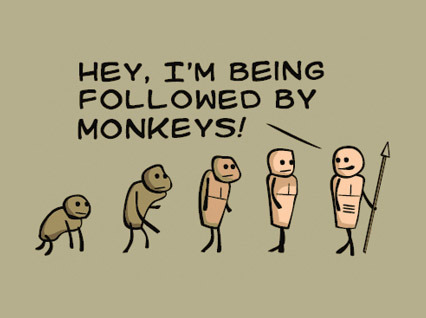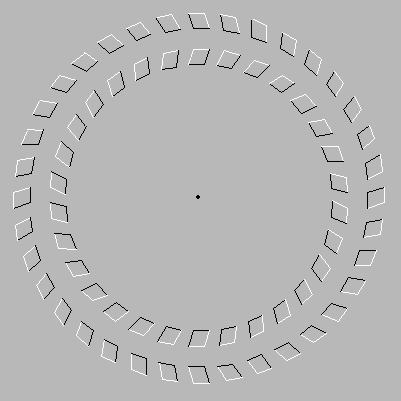Twitter & Tweets: Who Can Read What (And How And Why To Use The Dot).
/I started to use the mighty "." on Twitter today, and immediately got into about 50 confused conversations about it, most of which started "What's with the . thing?" Trying to tweet 50 different bitesized answers did not lessen the confusion, so I thought I'd explain here what I'm doing (or what I think I am doing).
May this post give you the strength to make the dot a good thing, the self-restraint to avoid making it a bad thing, and the wisdom to tell the difference.
 See? Many of humanity's problems, incredible as it seems, predate Twitter. (Explosm sell this as a T-shirt! Site seems down, so I've linked to info on the Cyanide & Happiness guys.)
See? Many of humanity's problems, incredible as it seems, predate Twitter. (Explosm sell this as a T-shirt! Site seems down, so I've linked to info on the Cyanide & Happiness guys.)
SOME BACKGROUND ON HOW USERS DRIVE TWITTER'S EVOLUTION
A lot of people, especially new users, are not entirely sure how Twitter works, or who can read what, when and how. This is unsurprising: Because Twitter has evolved so fast, features that didn't even exist a year ago are at the heart of the Twitter conversation now. Users are constantly finding new implications of those new features, and creatively using (& misusing) them, in turn. And those new, user-invented features and workarounds that are popular and useful get turned into new, official features: When I started using Twitter only a few months ago, for example, retweets had to be done by hand, and there was no agreed syntax ("Retweet", "(RT)", "RT:", "Via" and others were all in use.) ...Twitter only installed an official button for retweeting in September this year. (We will get to the meat of the matter after you jump the shark. With its black dot for an eye.)
SO WHO CAN READ WHAT?
Before we talk about the mighty dot, we need to be clear on how tweets work. As things stand today (and this wasn't true last year, and may not be true next year), this is who can read what. Let's say I send a nice ordinary tweet, like "I am eating the most amazing pickled shark testicles." That tweet
will appear in the stream of everyone who follows me. It also appears in my own stream (where I can read all the incoming tweets from those I follow), and on my own page (where all my tweets are stacked up one after the other.)
But if I reply directly to someone else's tweet, like this: "@sharklover Sorry, I forgot you were a vegetarian. And married to a shark. Whoops." ...then that reply will only appear in the streams of the people who follow BOTH me (@juliangough) and her (@sharklover). Twitter don't make this very clear, and it isn't intuitively obvious, so a huge number of Twitter users assume that everyone who follows them can read all their replies. Not so. However, that last tweet is defined by Twitter as a reply simply because it STARTS with a name, @sharklover. If I hand-crafted a reply like this: "Well listen, @sharklover, obviously I wouldn't have eaten his testicles if I'd known he was your husband" ... then, because it doesn't start with a name, Twitter will treat it as a regular ordinary tweet, and all my followers can see it in their stream, whether they follow @sharklover or not.
WHICH IS WHERE THE DOT COMES IN...
Which is, at last, where the dot comes in. Hitting reply is handy: there's the person's name, the cursor is blinking after it, all you have to do is type the message and send. Building your tweet either side of the other person's name, however, just so your reply will be visible to all your followers, is not handy, and can sound really awkward, like a tweeted, 140-character version of stilted Victorian dialogue: "So, @moriarty, we meet again, in the shadow of the Reichenbach Falls..."
Of course, most replies are not of general interest and the system, by hiding them from most of your followers, works fine. ("@mum I left @dad drunk in the coal shed.") But sometimes a reply would be of interest to many, or all, of your followers (not just those who follow you and the person you are replying to). For example, I sometimes get asked interesting questions about my novels, or about my old band: I know that a good chunk of my followers are fans who would appreciate seeing my reply. And sometimes you just want to open up the conversation with a reply, and give others a chance to join in. And sometimes you want to start a big fight.
But how do you quickly and easily convert the reply into an open message? You can't just type a letter, or letters, directly in front of the name with no space, like this: a@sharklover. That stops it from being treated as a reply by Twitter, sure, but any letters touching the front of the "@" mess up the name, stop it from being searchable, prevent it from appearing in the @replies box of the person you sent it to, and mean it is no longer hyperlinked (that is, you can't click on it and go to their page). So, what, add a letter and a space? A quick abbreviated explanation? It starts to get messy, and distracting. And eat up scarce characters.
But you CAN type non-letters, such as punctuation marks, directly in front of a name, without messing it up and breaking it as a link and all that bad stuff. And the simplest, smallest, least annoying punctuation mark is the full stop. This guy, inside the quotes: "."
So if I send this: ".@sharklover I've always loved you, I've had fins surgically attached also intromittant organs, feels weird having a double penis, marry me", now everybody who follows me can read it. Which may or may not be a good thing, but it's a nice option to have.
A WORD OF CAUTION
The dot allows a personal conversation to be overheard by many others, so use it sparingly. Think - is this private remark really going to interest many of my other friends? If not, don't dot. Otherwise you run the risk of being the person at the bar shouting loudly at their friend, in the vain hope of impressing the whole pub. Don't beat yourself up if you overuse it at the start and annoy a few friends. It is natural to get a bit carried away at first (he said, after an entire day's experience). I certainly did. But I had calmed down by teatime, and so should you. A cup of camomile should do it.
WHO INVENTED IT?
I've no idea, but I'd love if you could tell me. I first noticed guys like @glinner using the dot recently, I had no idea what it was, and (too shy to ask) worked out what it meant by context. I have noticed that comedians and scriptwriters are prone to use it. (The dot is particularly useful if you are replying to a friend with a cracker of a joke and don't want it wasted.) It just seems to have spontaneously evolved, because it was needed, and may have many mothers and fathers.
A FINAL THOUGHT ON DMs (DIRECT MESSAGES)
Oh yeah, while we are at it: there is one other type of tweet. DMs (direct messages) can only be sent to people who are following you, and can only be read by you-the-sender, and the individual you sent it to. But bear in mind, if YOU aren't following THEM, they can't DM you back, which can lead to an embarrassingly public tweet like this: "Sure thing @juliangough I'll DM you an answer to your DM requesting the name of my drug dealer as soon as you follow me." So it's probably best to follow people BEFORE you DM (direct message) them.
Also bear in mind that nothing in human cultural history has grown as fast as Twitter, and that this is just a snapshot of the evolving situation in late 2009. It will all change, change utterly, and within a few months this post will seem as quaint as advice on the kind of red flag your servant should be carrying as he walks sixty yards ahead of your self-propelled mechanical vehicle.
THE PREHISTORY OF TWITTER
For those interested in the prehistory of Twitter, and how such arcane events as the great #fixreplies revolt of May 2009 shaped the current Twitter universe, here's a couple of links:
The Evolution of Retweeting. This article from August 2009 (only two months ago as I write!) gives a flavour of how users drive the development of Twitter, and of how tentative and confused the developers can feel in the face of such pressure from below. The retweet option they initially planned to build is nothing like the one that they eventually delivered.
The Great #fixreplies Revolt of May 2009. This battle reshaped the modern @replies. A bit like the slaves' rebellion in Spartacus, the revolt failed but left an enduring legacy, and scared the pants off the Emperor (ie this is when the chaps who set up Twitter first realized they were not in fact in total control of it).
The Invention of @replies and @mentions. Back in November 2008, when the world was young, @replies were formally adopted by Twitter. This Twitter blog post now feels like the Magna Carta.
Throw in comments, advice, argument below, or attack me frenziedly on Twitter itself (@juliangough). Feel free to link to, copy, or pass this onto friends if you think it's helpful. And be nice to each other out there. Oh, it's all fun and games in the Twitter playground till somebody loses an eye.
Meanwhile, to reward you for reading so much stuff about such a small thing, here's a real dot to play with. Focus on it. Now lean forwards, and backwards. Feel the power of the mighty dot! (This probably won't work for you, Momus, or any other visitors with one eye.)


